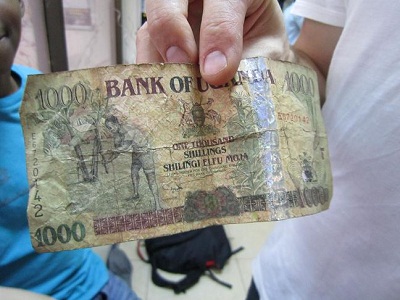
Eric Sarriot @ the Talk - Photo Credit: Ben Addom
“I suspect that the world you’re dealing with is even more complex than the world we’re dealing with in health…health is dealt with by doctors, a very simple minded people, but your field is probably more complex.” Those are the words of Eric Sarriot, Technical Director, CEDARS at ICF International.
Eric was speaking on the topic “Emergence of Sustainability in a Complex System: Are Lessons From the Health Sector Applicable to Food Security?” during January 2012 USAID’s Microlinks Breakfast Seminar in Washington DC.
Eric brought two challenging concepts together – “sustainability” and “systems” to help understand the question whether sustainability strategies for health system strengthening (HSS) can be applied to food security. He noted that development programs in general intervene on specific problems, gaps in performance, and deficits in capacity. And to do so, there is the need for workable plans and log frames. These imply a very rational use of linearity but when it comes to dealing with sustainability and the number of actors—‘stakeholders’—at play, it just gets too complicated or rather ‘complex’.

Photo Credit: CEDARS Center
So beginning with his view of a system, he argues that a complex, adaptive systems by some definitions will have a large number of agents/actors that are diverse and try to adapt to each other. The adaptation process to each other results in the complexity of the system. He went on to define sustainability in HSS as an (emerging) property of a system embedded in a larger environment in which interdependent actors through negotiated and coordinated social interactions, allow the expression of their respective and collective capabilities to maintain and improve the health of vulnerable population.
Using the sustainability framework developed at CEDARS through research with communities and practitioners, Eric shared their experiences with the health sector from Bangladesh. The health system in Bangladesh at some point was in equilibrium with interactions among diverse actors.

Process Towards new Equilibrium by CEDARS
This equilibrium was punctuated as a result of an external intervention that sent shock to the system leading to the shaking of the equilibrium. And by the end of the project, there was a new equilibrium which as achieved through things that were planned for and others that were not planned for. In effect, the actors found another way to interact that created the new equilibrium.
From this experience made available through a detailed report, the study posited that at least some of the lessons that have been learned about how health systems actually behave as “systems”—complex adaptive systems—may be relevant to the world of food security and value chain interventions. Also, observed is that complexity increases rather than decreases when it comes to sustainable food security and the role of value chains.
Can elements of this model help value chain efforts better plan for and evaluate the ultimate sustainability of food security of households?
Yes, I believe the elements of the sustainability framework for HSS can help agriculture and food security value chain system to better plan for and evaluate the ultimate sustainability of food security of households.
I totally agree with Eric on his statement that the world of food security, agriculture and value chain is more complex than the world of health. Firstly, I think the nature of the agricultural value chain – actors from research and development, input manufactures and suppliers, producers, transportation and logistics, processors and manufacturers, wholesalers and retailers, and the consumers – really makes it more complex than health.
Secondly, while “health services” aim at ensuring healthy lives of its users, “agricultural services” are aimed at building the capacities of its users to increase their productivity. For example, farmers are provided with agricultural advisory service to know when to sow their crops, when to spray, and when to market their products; and agricultural commodity traders are informed of the prices and locations of potential commodities to be able find the right market.
Thirdly, even though the health system is complex, all the actors have a common goal of providing health services to a vulnerable population in order to maintain and improve their health. So the users are more or less “passive recipients” of these services. Within the agriculture and food security value chain system, however, there are multiple recipients of the services as well as producers, making it more complex than health system. Farmers provide and receive agricultural services just as researchers, traders, and extension officers.
These features of the agriculture and food security value chain “system” and its larger environment with multiple interdependent actors, demand for a well coordinated and negotiated social interactions as required in the health system, to keep it sustained.
The place for ICTs
The complexity of the system and its associated interactions calls for effective communication networks, and this is where the importance of information and communication technologies (ICTs) could be realized. The sustainability framework presented by CEDARS, recognized the importance of a consistent data use to allow information-based decision-making and action. ICT for agriculture and food security projects should therefore be seen as value added services to ensure that actors within the system have access to timely and appropriate information for sustainable food security.
ICTs could be used in the following ways for increased information flow among the interacting actors:
- Capturing technologies for actors to interact among themselves to understand potentials and diagnose needs such as data collection, monitoring and evaluation tools could be very useful within the system.
- Communication tools to facilitate relationship building, and social network development such as social media tools that inform partners about services and users are good examples.
- Processing and system management tools to ensure sustenance of the relationships built through network formation can also keep the system in equilibrium.
- Communication and display media are also excellent ICTs for awareness creation and informing users about new products and their importance within the value chain.
How do we balance results and learning from these two systems?
I believe the key is collaboration. Realization of the ‘sustainability framework’ within the health system in any given community depends on the food security situation of that system. A closer look at the actors within the health system will reveal one or more ties with the food security and agriculture value chain system. Disturbing the equilibrium within the food security and agriculture value chain system will invariably disorganize the orientation of actors within the health system. Therefore to ensure that new equilibrium is maintained years after the intervention, actors must not see themselves as isolates but as components of the larger environment comprising of a number of systems.
Microlinks and its activities

Microlinks Staff Introducing the Breakfast Seminar - Photo Credit (Ben Addom)
Microlinks captures new learning in microenterprise development, disseminates it among practitioners, USAID mission staff, and other donors, and connects those actors to each other in order to improve development outcomes around the world. Using a knowledge-driven approach to microenterprise development, Microlinks aims to extend and multiply the impact of the learning and innovation developed through microenterprise research and practice. Visit Microlinks for more information on this presentation – the screencast and the transcript of the presentation, as well as future events.
The USAID’s Microenterprise Development office supports Microlinks and a broad array of knowledge-sharing tools, strategies, and events through the Knowledge-Driven Microenterprise Development program, implemented by The QED Group, LLC and its sub-contractors, International Resources Group and Training Resources Group.
 The Peninsula Taxi Association (PTA) will become the first taxi organisation to use a smart cards system for payment (image: Gateway)
The Peninsula Taxi Association (PTA) will become the first taxi organisation to use a smart cards system for payment (image: Gateway)


















































